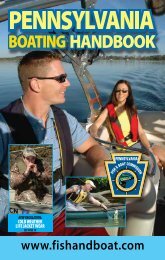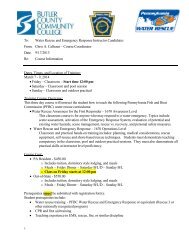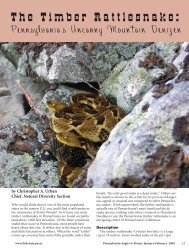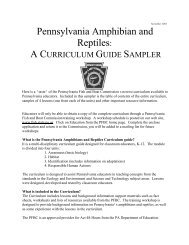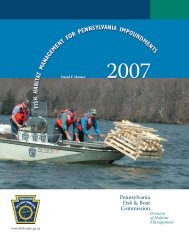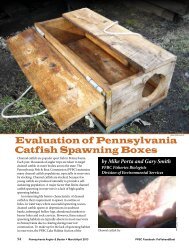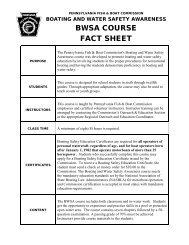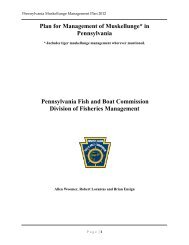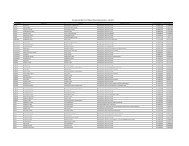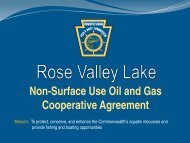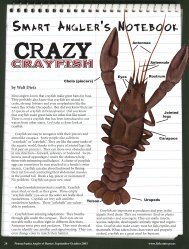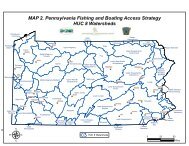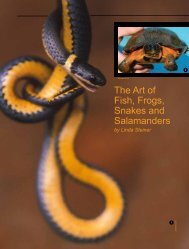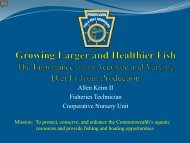^Tn^Z^Ei*] - Pennsylvania Fish and Boat Commission
^Tn^Z^Ei*] - Pennsylvania Fish and Boat Commission
^Tn^Z^Ei*] - Pennsylvania Fish and Boat Commission
You also want an ePaper? Increase the reach of your titles
YUMPU automatically turns print PDFs into web optimized ePapers that Google loves.
JJ e mies, of protection from floods, <strong>and</strong><br />
I cooling depths so necessary in sum-<br />
•f. <strong>Fish</strong>, like humans, are now fac-<br />
B a man-made housing shortage.<br />
:,&dercut banks, underwater roots,<br />
*8s, <strong>and</strong> snags all once under the impended<br />
waters of the mill dam, <strong>and</strong><br />
nVorite homes for a host of fishes,<br />
I* 6 now under water only at flood<br />
Bfe. Homes <strong>and</strong> havens thus decoyed<br />
place fish at the mercy of<br />
•to, hawks, cranes, turtles, snakes,<br />
|j C coons <strong>and</strong> a host of other enemies.<br />
j° longer can the bass escape to the<br />
rPths, or to his hollow sunken-log<br />
0t<br />
ne, or to the haven of tangled tree<br />
jw°ts. These are all largely destroyed.<br />
^°r can the fish, during the heat of<br />
f^mer, retire to water deep enough<br />
^ afford shade <strong>and</strong> cool enough to<br />
j^vide extra oxygen. The depths, too,<br />
^ v e been destroyed.<br />
^Apart from the anglers loss the loss<br />
'human playgrounds has been conquerable.<br />
In fact, it would be safe<br />
assess the purely recreational loss<br />
J? being tremendous. Youngsters, <strong>and</strong><br />
'?sters too, frequented the "old swim-<br />
J^g hole." <strong>Boat</strong>ing, swimming,<br />
Joeing <strong>and</strong> winter skating were all<br />
£*t of the value of the mill dam.<br />
^ough these dams were privately<br />
j.^ed they became, in a very prac-<br />
' c al sense, public parks. People in<br />
jf^eral seemed to take it for granted<br />
J^t the dams were for their enjoy-<br />
. e *it. It is a testimony to the kindli-<br />
JJss <strong>and</strong> generosity of the owners,<br />
o made all the repairs <strong>and</strong> did all<br />
p 6 work, that this feeling lasted as<br />
^g as the dams.<br />
v In addition to their value to fisheri<br />
6r i, campers, canoeists, trappers,<br />
^titers, an d skaters the dams had a<br />
] to bable conservation value in other<br />
. Ss obvious ways. Though the ac-<br />
J^acy of the following ideas needs<br />
,. le ntific investigation they are worthy<br />
, mention. From observation it<br />
^Pears that the dams helped to<br />
^intain a more regular flow of water<br />
all seasons. Excessively low water<br />
3s<br />
rare. Unnecessary <strong>and</strong> unwanted<br />
Ipluatic vegetation was held to a min-<br />
• j^m in areas of deeper water. Some<br />
'fetation is necessary in our streams<br />
Mp not the choked condition found<br />
K s ome of the ab<strong>and</strong>oned dams. They<br />
ij/jj-haps raised the level of the water<br />
?"e of nearby l<strong>and</strong>s, in some cases<br />
, distinct benefit to farmers. They<br />
^t^ainly helped to decrease the load<br />
K Sediment carried by the stream <strong>and</strong><br />
v^Uced to a minimum the muddy<br />
n^ter periods after heavy rains. All<br />
^ 6s e things <strong>and</strong> doubtless many more<br />
;j) 6f e lost when the dams were ruined<br />
j ^ugh neglect.<br />
k Ift all sportsmen's groups stream im-<br />
^Vement, fish culture, <strong>and</strong> conser-<br />
{j'ion are main topics for discussion.<br />
^ s toration of mill dams would be an<br />
A<br />
rEMBER—1949<br />
active step in all three directions.<br />
Bass rearing ponds would be less<br />
necessary if present fish populations<br />
have a chance to increase naturally.<br />
Most conservationists agree that the<br />
mere dumping of fish into a stream<br />
inadequate to support them is senseless<br />
waste. Where water acreage,<br />
depth, reasonable protection <strong>and</strong><br />
proper temperatures are lacking they<br />
must be provided before restocking<br />
will be effective. Restoration of dams<br />
would help to provide proper habitat<br />
Eleven-year-old Paul Kline, of Bunker Hill,<br />
proudly displays the prize small-mouth bass he<br />
l<strong>and</strong>ed below the falls in the Swatara Creek at<br />
Bunker Hill. .Paul lured the 19", Wt lb. beauty<br />
with a hellgrammite. He was using 15 lb. test<br />
line.<br />
<strong>and</strong> at the same time provide recreation<br />
for many persons.<br />
Sportsmen have a duty to see that<br />
their "sporting dollar" provides them<br />
with maximum returns. Government<br />
officials charged with the spending of<br />
the sportsmen's money have a similar<br />
duty to see that all money is spent<br />
wisely <strong>and</strong> with foresight. Tax money,<br />
whether it, be from license fees or other<br />
sources should buy not only fish but<br />
stream improvement <strong>and</strong> recreational<br />
areas as well. Streams without fish<br />
are as poor an investment as fish<br />
without streams. To ignore human resources<br />
is equally foolish. The three<br />
elements; fish, water, <strong>and</strong> recreation<br />
must be considered together. Restore<br />
the mill dams <strong>and</strong> give the fish a<br />
break!<br />
What's New<br />
Reviewed by Hugh Johnson<br />
in <strong>Fish</strong>ing Books<br />
It has always been a source of wonder to<br />
me that, in the great <strong>and</strong> increasing number<br />
of fishing books published, there have<br />
been so few written specifically for boys.<br />
Basic habits of behavior, including those<br />
of sportsmanship, are formed in the early<br />
impressionable years, <strong>and</strong> it is certainly in<br />
the best interests of continued good fishing<br />
for all that those of us who have achieved<br />
a degree of maturity in angling should pass<br />
on our lessons, experience, <strong>and</strong> hopes to the<br />
younger generation which is getting ready<br />
to take over. This is already being done in<br />
the field—but on altogether too small a scale<br />
—by fishermen who take the time, <strong>and</strong> have<br />
fun in the bargain, to give the youngsters<br />
a tip or two on stream or lake.<br />
But our angling writers have muffed the<br />
challenge pretty thoroughly, <strong>and</strong> if one were<br />
to judge only from the age appeal represented<br />
on the shelves of fishing literature,<br />
one would assume that nobody under 20<br />
years of age ever did any serious game fishing.<br />
One exception—Lee Wulff's Let's Go<br />
<strong>Fish</strong>ing, an excellent, basic book of instruction<br />
for boys up to about 12 years of age—<br />
has stood alone as angling literature's one<br />
respectable curtsy to the existence of a<br />
junior brotherhood of fishermen.<br />
So, it is with rousing cheers <strong>and</strong> congratulations<br />
that we shake the h<strong>and</strong>s of Ollie<br />
Rodman, publisher of Outdoors Magazine,<br />
<strong>and</strong> Edward C. Janes, an associate editor on<br />
the same magazine, for having recognized<br />
this gap in the 12 to 16 year bracket <strong>and</strong> for<br />
having filled it magnificently by writing<br />
The Boy's Complete Book of Fresh <strong>and</strong> Salt<br />
Water <strong>Fish</strong>ing (published on July 20, 1949<br />
by Little, Brown <strong>and</strong> Company, Boston,<br />
Mass. $3.50). The section on Fresh Water<br />
<strong>Fish</strong>ing has 160 pages <strong>and</strong> covers bait fishing<br />
for pan fish, pickerel, bass, <strong>and</strong> trout; trolling,<br />
plug casting, fly fishing, spinning; <strong>and</strong><br />
has chapters on streamcraft, ice fishing, how<br />
to clean fish, fishing knots, tackle care, <strong>and</strong><br />
even one on how to catch bait. The section<br />
on Salt Water <strong>Fish</strong>ing is short, 108<br />
pages, but contains all the basic information<br />
a youngster needs for launching into salt<br />
water angling. The book is generously illustrated.<br />
The publisher deserves a word of credit<br />
for setting up <strong>and</strong> designing the book in such<br />
a way that it doesn't look like a "juvenile,"<br />
but reflects the he-man, outdoor informality<br />
of the text. The assured success of this book<br />
in its appeal to 12 to 16 year old readers<br />
springs from the fact that it is written in a<br />
friendly atmosphere of equality between<br />
author <strong>and</strong> young reader—none of the patronizing<br />
elder uncle stuff—<strong>and</strong> good techniques<br />
<strong>and</strong> attitudes in fishing are "sold"<br />
to the reader without a single don't or note<br />
of dogma in the whole book. I would like<br />
to have seen a chapter on the fundamentals<br />
of fly-tying included in the Fresh Water<br />
<strong>Fish</strong>ing Section, because plenty of boys de-<br />
(Turn to page 13)<br />
!)


![^Tn^Z^Ei*] - Pennsylvania Fish and Boat Commission](https://img.yumpu.com/12335467/11/500x640/tnzei-pennsylvania-fish-and-boat-commission.jpg)
